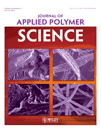Effect of blending sequence on the morphology and properties of polyamide 6/EPDM-g-MA/epoxy blends
Abstract
The ternary blends of polyamide 6/maleated ethylene-propylene-diene rubber/epoxy (PA6/EPDM-g-MA/EP) were prepared by a twin-screw extruder with four different blending sequences. With the variation of blending sequence, the ternary blends presented distinct morphology and mechanical properties because of different interactions induced by various reactive orders. The addition of epoxy could increase the viscosity of the PA6 matrix, but a considerably larger size of the dispersed rubber phase was observed while first preblending PA6 with epoxy followed by blending a premix of PA6/EP with EDPM-g-MA, which was attested by rheological behaviors and SEM observations. It was probably ascribed to the fact that the great increase of the interfacial tension between the matrix and rubber phase aroused a great coalescence of rubber particles. The presence of epoxy in the rubber phase reduced the rubber's ability to cavitate so that the toughening efficiency of the EPDM-g-MA was decreased. The results of mechanical testing revealed that the optimum blending sequence to achieve balanced mechanical properties is blending PA6, EPDM-g-MA, and epoxy simultaneously in which the detrimental reactions might be effectively suppressed. In addition, thermal properties were investigated by TG and DSC, and the results showed that there was no distinct difference. © 2011 Wiley Periodicals, Inc. J Appl Polym Sci, 2011




